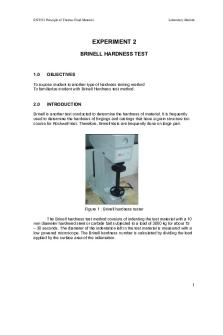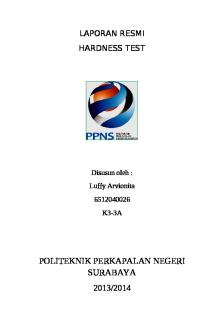Brinell Hardness Test Lab #1 PDF

| Title | Brinell Hardness Test Lab #1 |
|---|---|
| Author | Jack Emond |
| Course | Mechanics of Materials |
| Institution | Concordia University |
| Pages | 6 |
| File Size | 86.8 KB |
| File Type | |
| Total Downloads | 16 |
| Total Views | 136 |
Summary
LAB 1 for ENGR 244...
Description
Brinell Hardness Test LAB #1 Jack Emond |40018940| Section HM-X | 01-02-18 Group members: Thomas Bugden
Objective The objective of this lab is to determine and examine the deformation of metals such as Aluminum and Steel using the Brinell Hardness test method.
Introduction In this experiment I can predict that the steel sample will have a much greater hardness compared to the aluminum sample. We will be applying double the force to the steel sample and I assume the indention difference between the samples will be very minute. Since steel is almost always used for structures and bridges we can predict the ability to resist deformation will be greater than the latter aluminum which is usually chosen for its lightweight for things like bikes and parts of the car. The Brinell Hardness test is practical, quick and easy to set up. Being a non-destructive test, it is great for testing any small material in and orderly fashion for calculations and design of building materials and components of everyday items such as gears, casings, frames and much more. This test can be replaced by more accurate but longer and more destructive tests such as the Vickers or Rockwell Hardness tests
Procedure 1.
Place your first sample one the Lower Adapter, make sure the ball is positioned in between the center and the edge of the sample. 2. Apply a load of 10 000 N (for Steel) and 5000 N (for Aluminum) for 15 seconds 3. After removing your sample, measure it with a microscope to the accuracy of 0.1mm using an x and y axis and taking the average of the two. 4. Repeat the first 3 steps (at least) two more times making sure to space out the indentations by 2.5x the diameter of your first reading.
PAGE 1
Results All calculations were made using MatLab 2017 (Student Edition)
Ex. >> BrinellCalc What is the diameter of the indent?2.9 What is the load? (in N)10099 Load in Kg is 1029.46 Depth of indentation is 0.2149 mm Area of indentation is 6.7502 mm^2 Brinell Hardness is 152.5072 Kg/mm^2
For Script and Tables see next pages Formulas used:
HB=
P ( Kg ) 2 A ( mm )
(
1 ( ) 2
πD D −( D 2−d2 ) A= pi∗D∗t= 2 d=
)
dx + dy 2 PAGE 2
PAGE 3
PAGE 4
Discussion/Conclusion Hardness Tests in general are very practical for use in engineering to determine the overall ability to resist deformation. The Brinell hardness is quick and easy to preform making it advantageous for small rough objects which may not be suitable for other tests. Other tests include Rockwell hardness test which similar to the Brinell Test but uses a diamond or a ball but consists of 2 loads, a preliminary and a major load. There is also the Vickers Hardness test which uses a diamond but is only used on thin sheets of metals or materials and rarely goes over 30 kg of pressure. The Brinell Test is prone to errors due to the fact it is usually preformed on smaller objects where if the indentation is made to close to the edge it can cause an erogenous deformation leading to the deviation of the calculations causing it to bring down the hardness number. Where as if the indentation is made to close to the center it will be more difficult to indent leading to a greater HB number. Other sources of error could be placing the indentation to close to one and other, causing weakening of the member leading to a deformed or larger diameter. Human errors also could affect the results such as miss reading the diameter with the microscope, forgetting to zero the Digital load read out or even leaving the press on for more than 15 seconds. Solutions to theses would be using more accurate electronic measuring systems and double checking all the work.
References: Mechanics of Materials 6th Edition - By (Ferdinand P. Beer & E. Russell Johnston, Jr & John T. Dewolf & David F. Mazurek) “TEST TYPES.” Test Types, www.hardnesstesters.com/test-types.
PAGE 5...
Similar Free PDFs

Lab 1 - Brinell Hardness Test
- 15 Pages

Brinell Hardness Test Lab #1
- 6 Pages

E2- Brinell Hardness TEST
- 5 Pages

laporan uji bahan hardness test
- 8 Pages

EXPERIMENT 3 HARDNESS TEST
- 8 Pages

In-person lab water hardness
- 5 Pages

Water Hardness Lab Report
- 5 Pages

Vickers Hardness Testing
- 9 Pages

LAB 1 - Torsion TEST - 2020
- 9 Pages

Lab 1 - Lab 1
- 6 Pages
Popular Institutions
- Tinajero National High School - Annex
- Politeknik Caltex Riau
- Yokohama City University
- SGT University
- University of Al-Qadisiyah
- Divine Word College of Vigan
- Techniek College Rotterdam
- Universidade de Santiago
- Universiti Teknologi MARA Cawangan Johor Kampus Pasir Gudang
- Poltekkes Kemenkes Yogyakarta
- Baguio City National High School
- Colegio san marcos
- preparatoria uno
- Centro de Bachillerato Tecnológico Industrial y de Servicios No. 107
- Dalian Maritime University
- Quang Trung Secondary School
- Colegio Tecnológico en Informática
- Corporación Regional de Educación Superior
- Grupo CEDVA
- Dar Al Uloom University
- Centro de Estudios Preuniversitarios de la Universidad Nacional de Ingeniería
- 上智大学
- Aakash International School, Nuna Majara
- San Felipe Neri Catholic School
- Kang Chiao International School - New Taipei City
- Misamis Occidental National High School
- Institución Educativa Escuela Normal Juan Ladrilleros
- Kolehiyo ng Pantukan
- Batanes State College
- Instituto Continental
- Sekolah Menengah Kejuruan Kesehatan Kaltara (Tarakan)
- Colegio de La Inmaculada Concepcion - Cebu





